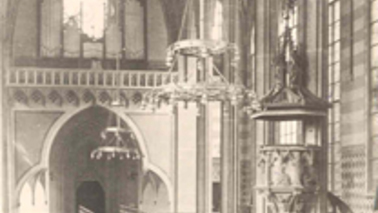
Lord Mayor Smidt Memorial Church
The original city plan did not envisage a church, so the first Bremerhaven inhabitants had to worship at St. Dionysus's (dating from around 1200) in nearby Lehe. But a local initiative, supported by the Bremen Lord Mayor and founder of Bremerhaven, Johann Smidt (1773-1857), convinced the City Council of Bremen to build a church. Construction was commenced in 1846, but the muddy soil caused difficulties and work had to stop. In 1853, the architect Simon Loschen (1818-1902) started again, planning a church consisting of three naves with apse and west tower in contemporary neo-gothic style and brickwork, the latter not unusual in northern Germany. But classical elements were also used. The top of the steeple (height 86 metres) resembles that of Freiburg cathedral in southwest Germany. Loschen was one of the most important protagonists of the neo-gothic style in northern Germany, along with the renowned Hanover architect Carl Wilhelm Hase.
However during construction works, some disputes occurred and Loschen resigned. Tragically, he died later in poverty. His successor Louis Löschner (1825-1894) continued with the original plans and was able to complete the works in 1870. Art historians regard this building as one of the most important neo-gothic churches in northern Germany. Meanwhile, this style is said to be of artistic value, a far more positive judgement than that of past generations.
A special feature of the church is its dedication to a non-clerical person. Some of these so-called memorial churches were built in Germany during the 19th and 20th centuries, but they are quite rare. The Kaiser Wilhelm memorial church in Berlin is one of the most renowned.
Bremerhaven people like to call their church the “Great Church”. Inauguration took place as early as 1855 and it was used from the beginning by all denominations of the protestant church. For this reason, statues of Jesus Christ, Luther and Zwingli are to be found on the western wall.
The firebombing of 1944 totally destroyed the interior and the pastor's house nearby. Rebuilding, together with all interior decoration, was completed in 1960. The funds came from the Bremerhaven population.

